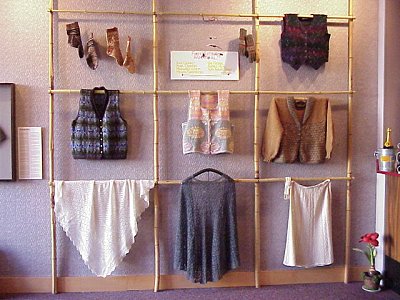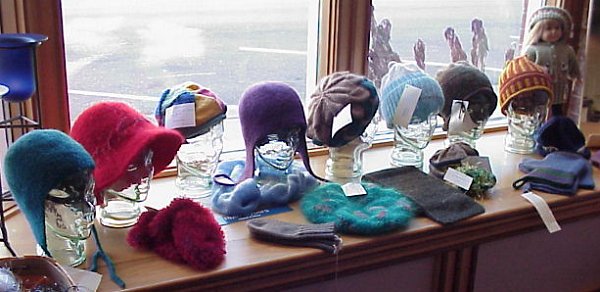| Ruth Knight Sybers
- Knitting has been a thread running through most of my life.
My mother's knitting class prior to World War II thought it was fun to
teach me to knit. I think that I learned to knit mittens early on,
using the teacher's chart to customize the knitting to the recipient's
hand and the gauge. It still seems like a trick!
Knitting in college classes, knitting during
Christmas vacation -- during college and teaching days was always a relaxing
time. As I taught home economics in high school and later at the
UW-Madison, my formal training in textiles was enhanced. It was many
years later at a meeting of the Madison Area Knitters' Guild that I put
my knitting down and observed five different methods of knitting by people
around me. That Guild made me realize that there is a whole world
of knitting out there -- as Maggie Rhegetti said "There is one knit stitch
and you spend the rest of your life learning what to do with it" (well
maybe not those exact words).
Early on at the Guild Jean Blakely Jensen
gave a glowing account of her recent attendance at Elizabeth Zimmermann's/Meg
Swansen's Knitting Camp -- I couldn't wait to go -- and have been going
since. I am definitely a blind follower.
Many years later, after my husband died,
I signed up for knitting trips, camps, and soaked up all I could, trying
hard to not be only a process person (I can't count the number of color
classes I have taken trying to get color theory to come naturally).
With the creation of a fine dining restaurant
in Monticello, Wisconsin by my daughter and son-in-law, the decision to
decorate with textiles has changed my life. With a friend, Rhoda
Braunschweig, who I met as a graduate student in textiles at UW-Madison
to guide me, we have been having lots of fun doing the textile displays.
I now knit a lot. I have a business Knitter's Treat, LLC that now
sponsors workshops in Monticello by excellent international teachers.
I have a small shop and retirement has blossomed into doing things I like
to do -- everyone's dream!
Socks: Lucy Neatby's Bicycle Socks
and Fiesta Feet patterns (Lucy has taught here several times)
Vest: From Sweaters From Camp, edited
by Meg Swansen (adapted)
Shawl: Beauty and the Bias, pattern
by Two Old Bags
Faroese Shawl: Pattern by Mryna Stahlman |

